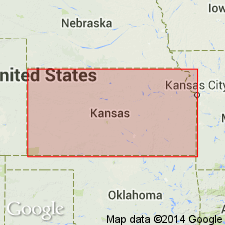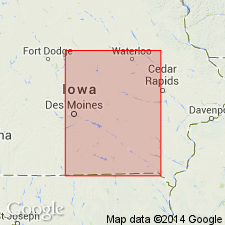
- Usage in publication:
-
- Blackjack Creek limestone member
- Modifications:
-
- Revised
- AAPG geologic province:
-
- Cherokee basin
Summary:
Pg. 304-305. Blackjack Creek limestone member of Fort Scott limestone. Base of Marmaton group in southeastern Kansas and Henrietta group in Missouri. Previously called "lower Fort Scott" or "Cement rock." At exposure in Johnson County, Missouri [type locality] (in sec. 13, T. 45 N., R. 26 W.) is one bed of brown, earthy, slightly crystalline limestone, 4 feet thick. At Fort Scott limestone type exposure (in NE/4 sec. 19, T. 25 S., R. 25 E., Bourbon County, Kansas) described as blue-gray massive limestone with conchoidal fracture, 5.2 feet thick. In Kansas, thickens southward; thickness ranges from about 5 feet in Bourbon County to 16+ feet thick in Labette County. Overlies Cherokee shale; underlies Little Osage shale member (new) of Fort Scott limestone of Marmaton group. Age is Middle Pennsylvanian (Des Moines); contains fossil CHAETETES. Report includes cross section.
[Misprint: US geologic names lexicon (USGS Bull. 1200, p. 365) cites J.M. Jewett (1951). Should be 1941.]
Source: US geologic names lexicon (USGS Bull. 1200, p. 365); supplemental information from GNU records (USGS DDS-6; Denver GNULEX).

- Usage in publication:
-
- Blackjack Creek Limestone Member
- Modifications:
-
- Revised
- AAPG geologic province:
-
- Iowa shelf
Summary:
Extended into Lucas Co, IA on the Iowa shelf from MO as the upper member of the newly named Mouse Creek Formation, basal formation of Marmaton Group of Des Moines Supergroup. Overlies Excello Shale Member of Mouse Creek. Underlies Morgan School Shale (named) of Marmaton Group. In this area, consists of a single massive bed of argillaceous, skeletal calcilutite, 2-4 ft thick. Nomenclature chart. Cross section. Of Pennsylvanian, Desmoinesian age.
Source: GNU records (USGS DDS-6; Denver GNULEX).
For more information, please contact Nancy Stamm, Geologic Names Committee Secretary.
Asterisk (*) indicates published by U.S. Geological Survey authors.
"No current usage" (†) implies that a name has been abandoned or has fallen into disuse. Former usage and, if known, replacement name given in parentheses ( ).
Slash (/) indicates name conflicts with nomenclatural guidelines (CSN, 1933; ACSN, 1961, 1970; NACSN, 1983, 2005, 2021). May be explained within brackets ([ ]).

